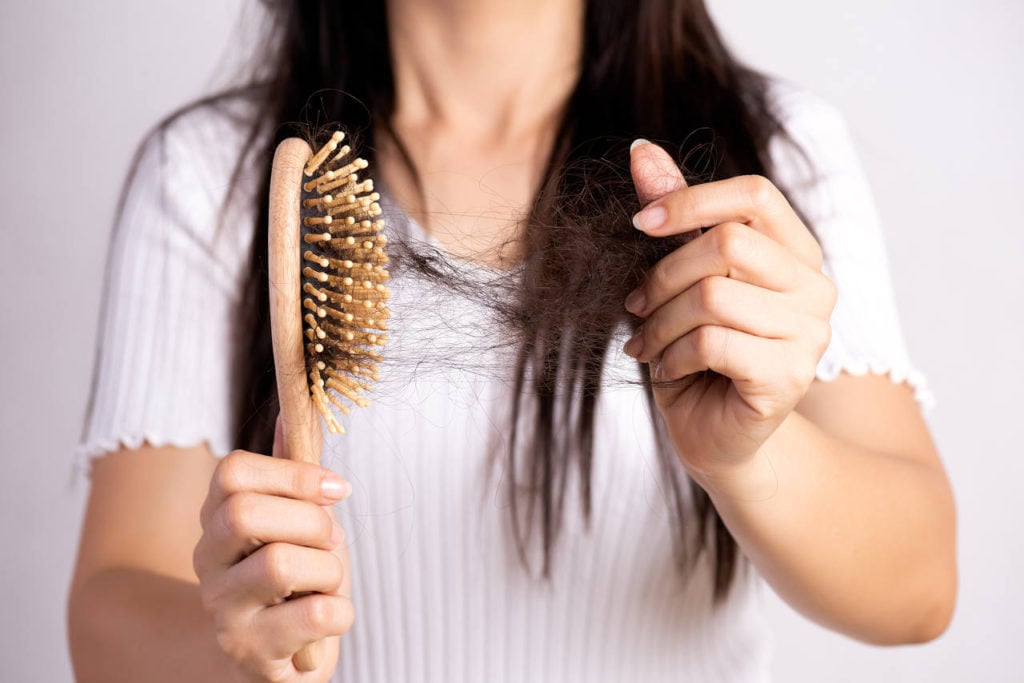
Female Hair Loss and Pattern Baldness: What to Expect?
Hair loss affects both men and women, with studies indicating that over 50% of women experience it at some stage. Experiencing significant hair loss beyond the natural shedding process can be particularly distressing, especially for women who associate their hair with femininity and take pride in their appearance.
Below, we discuss the various factors that contribute to female hair loss and the relevant treatment options to help you.
Summary
- Female Pattern Baldness
- Other Types of Hair Loss in Women
- Reasons for Hair Loss in Women
- How Common Is Hair Loss in Women?
- What Are the Signs of Hair Loss in Women?
- How To Diagnose Female Hair Loss?
- How To Stop Hair Loss in Women?
- How Does Elithair Treat Women’s Hair Loss?
Female Pattern Baldness
Female pattern baldness — also known as androgenetic alopecia — is the most common type of hair loss in women, characterised by gradual thinning of the hair, typically at the crown and along the parting line.
Unlike male-pattern balding, women often experience an overall thinning beginning from the central part and crown of the scalp, without any receding hairline. In the early stages of female pattern hair loss, the appearance of thinning hair can typically be masked by certain hairstyles. However, this is just a temporary fix, and the issue will typically progress to a point where such solutions are no longer effective.
What is female pattern baldness?
Medical professionals use the Ludwig Classification to categorise female pattern hair loss:
- Type I indicates minimal thinning, which can be concealed with styling methods.
- Type II features reduced volume and visible widening of the central part.
- Type III describes diffused thinning, resulting in a translucent appearance on the top of the scalp.
What causes female pattern baldness?
Hair loss is, by and large, a natural part of the ageing process. Each strand of hair grows from a microscopic cavity in the skin known as a follicle. Typically, baldness occurs as these follicles gradually shrink over time, leading to the production of shorter, finer hair. Eventually, the follicles cease to produce new hair, even though they remain alive. This means there could be the potential for regrowth.
The primary causes of female pattern baldness include:
- Ageing
- Fluctuations in androgen hormone levels, which can promote masculine secondary sex traits
- Family history of baldness in either gender
- Excessive blood loss during menstruation
- Certain medications, such as oestrogen-containing oral contraceptives
Stages of female pattern baldness
The Sinclair scale outlines five stages of female pattern baldness:
- Stage 1: Minimal to no hair loss.
- Stage 2: A slight separation appears along the centre hair part.
- Stage 3: A broader gap develops along the centre part, with hair loss on both sides.
- Stage 4: Bald patches emerge near the hairline.
- Stage 5: Severe hair loss is evident.
Treatment for female pattern baldness
Without intervention, hair loss in female pattern baldness becomes permanent. Typically, it manifests as mild to moderate, and treatment may not be necessary if you're content with your appearance. That said, if you are concerned with the effect that female pattern hair loss is having or has had on your appearance, there are some effective treatment options available, including:
- Minoxidil: A topical solution applied to the scalp, promoting hair growth and slowing down further loss.
- Hair transplant: A surgical procedure involving the transplantation of hair follicles from donor areas to thinning or balding areas on the scalp.
- Hairpieces: A non-surgical option involving the use of wigs or hairpieces to conceal bald patches and restore a fuller appearance.
These treatments offer varying degrees of effectiveness and may be used alone or in combination with one another to address female pattern baldness and improve overall hair density and appearance. Consulting with a healthcare professional can help determine the most suitable treatment plan for you.
Coping with female pattern baldness
If you are struggling with female baldness, you don't need to suffer in silence. In fact, coping with female pattern baldness often involves embracing self-confidence through various methods, such as:
- Experimenting with stylish hats, scarves, or headwraps.
- Exploring hair styling techniques that work with thinning hair.
- Seeking advice and support from hair care professionals or support groups.
- Embracing self-love and focusing on inner beauty and strengths.
Other Types of Hair Loss in Women
Hair loss can come in many different forms, with many different causes. Before seeking treatment for female hair loss, it is important to seek medical help in ascertaining the source of the issue. Female pattern hair loss, or hereditary hair loss in women, is not the only culprit. Below, you'll learn some other common causes of female baldness.
Alopecia Areata
Alopecia areata is an autoimmune condition in which the immune system mistakenly attacks and kills healthy hair follicles. This results in hair loss and, eventually, conspicuous bald patches. What makes alopecia areata different from many other common causes of women's hair loss is that the bald spots appear without any redness or scarring on the scalp.
Recovery from alopecia areata can take six months to a year, with patches of loss sometimes making surprise returns. People who have previously suffered from alopecia areta often report Minoxidil offers a temporary fix, while corticosteroids combat the body’s follicle attack, encouraging regrowth.
In cases of severe alopecia, a hair transplant is the lasting solution. With innovative methods like the SDHI technique, Elithair promises enduring results of strong, vibrant hair.
Anagen Effluvium
Anagen Effluvium is a type of hair loss resulting from the disruption of the hair growth phase (anagen phase). It is commonly caused by factors like chemotherapy, radiation therapy, or certain medications. Sudden hair loss can happen anywhere on your body and often occurs very soon after cancer treatment has begun.
While hair can regrow following the end of chemotherapy or radiation therapy, hair loss can be permanent if the hair follicles become damaged. Minoxidil can help with regrowth following cancer treatment until the hair naturally regrows.
Scalp cooling during chemotherapy has also provided good results in reducing hair loss. However, permanently damaged hair follicles will require a hair transplant for lasting regrowth in that area.
Traction alopecia
Traction alopecia is hair loss caused by repeated pulling or tension on the hair follicles. Tight hairstyles like braids, weaves, or ponytails are common culprits.
Severe cases can even lead to cicatricial or frontal fibrosing alopecia due to tight hairstyles, causing inflammation, irritation, and itching. In this case, Inflammation can scar the area and permanently damage hair follicles, preventing future growth.
Supplements with biotin and keratin can help to enhance hair health. Medications, both oral and topical can also aid regrowth but require consistent use to maintain results. But in severe cases, early-diagnosed hair transplants, especially for cicatricial alopecia, provide a lasting solution.
Telogen Effluvium
Telogen effluvium is a type of hair loss resulting from the disruption of the hair growth phase (anagen phase). When more hairs are in the resting phase than in the growing phase, extensive hair shedding and sudden hair loss in women can occur.
The core reasons as to why this happens are ambiguous, but studies suggest a strong relation to unexpected physical stress as the trigger. This could be attributed to poor mental health or grief.
Telogen effluvium can last for as long as 6 to 8 months before resolving. However, short-term solutions can be helpful to help hair grow faster, including microneedling and PRP treatment. There are also topical hair products which can help stimulate the hair follicles.
Postpartum hair loss
Postpartum hair loss occurs after childbirth when hormonal changes cause hair follicles to enter the resting phase prematurely. This leads to excessive shedding, typically starting around three months after delivery.
While distressing, it's usually temporary, with hair regrowth returning to normal within six to twelve months postpartum. Maintaining a healthy diet, managing stress, and gentle hair care can help mitigate the effects.
Menopause and female hair loss
Menopause-related hair loss in women, often due to hormonal changes, manifests as thinning or shedding. Treatments include hormone replacement therapy (HRT) to restore hormonal balance, minoxidil to promote hair growth, and supplements like biotin and iron to support hair health.
Additionally, lifestyle changes and stress management can help mitigate hair loss symptoms.
Reasons for Hair Loss in Women

There are clear contrasts between men and women when it comes to hair thinning. Here are the main reasons for female hair loss:
- Genetics: The hereditary condition androgenetic alopecia (AGA) causes hair follicles to shrink, resulting in thinner hair. Affects 50% of women over 50.
- Stress or illness: Temporary hair loss triggered by stress, illness, or medication, often after major life events known as telogen effluvium.
- Thyroid problems: Both hyperthyroidism and hypothyroidism can lead to hair loss.
- Nutritional deficiencies: Iron, vitamin B12, and zinc deficiencies can cause hair loss.
- Medications: Certain drugs like chemotherapy medications and anti-thyroid drugs may induce hair loss.
- Medical conditions: Conditions such as alopecia areata, lupus, and polycystic ovary syndrome (PCOS) can also contribute to hair loss.
How Common Is Hair Loss in Women?
Hair loss in women is more common than often perceived. Studies suggest that approximately 40% of women experience noticeable hair loss by the age of 50. Among postmenopausal women, the prevalence increases to nearly 75%. In fact, according to the NHS, 8 million women in the UK experience hair loss or some type of alopecia.
While often associated with ageing, hair loss can also affect younger women, impacting their confidence and quality of life.
What Are the Signs of Hair Loss in Women?
Signs of hair loss in women typically begin subtly and may progress gradually over time:
- Increased shedding noticed during brushing or washing hair.
- Thinning of hair, particularly around the crown or part line.
- Widening of the hair part or scalp becoming more visible.
- Noticeable decrease in hair volume and density.
- Receding hairline or bald patches becoming apparent.
If left untreated, hair loss may progress, leading to more extensive thinning or balding areas on the scalp. Because of this, you must seek early intervention to mitigate against worsening symptoms.
How To Diagnose Female Hair Loss?
Diagnosing female hair loss typically involves a comprehensive evaluation by a healthcare professional specialising in hair disorders. This may include:
- Physical examination of the scalp and hair.
- Detailed medical history assessment.
- Blood tests to check for underlying conditions like thyroid disorders or nutritional deficiencies.
- Scalp biopsy in some cases for a definitive diagnosis.
If you suspect hair loss, consult a medical professional promptly for an accurate diagnosis and personalised treatment plan tailored to your specific needs.
How To Stop Hair Loss in Women?
While hormonal imbalances and gender-specific factors like pregnancy and nutritional deficiencies take the lead in female hair loss, there are ways in which women can prevent female pattern baldness and other forms of hair loss. These include:
- Maintain a balanced diet rich in iron, protein, and essential vitamins and minerals.
- Incorporate iron-rich foods like spinach, lentils, and red meat into your meals.
- Limit the use of damaging hair treatments like bleaching, dyeing, and excessive heat styling.
- Avoid smoking, which can restrict blood flow to the scalp and contribute to hair loss.
- Protect your hair from sun damage by wearing hats or using UV-protective products when exposed to sunlight.
How Does Elithair Treat Women’s Hair Loss?
If you identify as female and choose to go the route of a hair transplant as a permanent solution, Elithair is on hand. Our skilled surgeons utilise advanced techniques, such as Follicular Unit Extraction (FUE), to transplant healthy hair follicles from donor areas to thinning or balding areas on the scalp.
With meticulous attention to detail and a focus on natural-looking results, we offer personalised treatment plans tailored to each woman's unique hair loss pattern and aesthetic goals.
Elithair is committed to providing effective and lasting solutions to restore hair density and confidence in women experiencing hair loss. Contact us today to book your free consultation.
FAQ
What role do genetics play in hair loss in women?
Genetics can play a significant role in hair loss, with conditions like androgenetic alopecia often inherited from parents. This condition causes hair follicles to shrink, leading to thinner hair and eventual hair loss.
How do hormonal changes impact hair loss in women?
Hormonal changes, particularly during menopause, pregnancy, or due to thyroid issues, can significantly impact hair growth cycles, often leading to increased hair shedding or thinning.
Are there any effective home remedies for managing hair loss in women?
Home remedies such as scalp massages, essential oils (like rosemary or peppermint oil), and a balanced diet rich in vitamins and minerals can support hair health and potentially reduce hair loss.
What are the psychological effects of hair loss in women, and how can they be managed?
Hair loss can lead to emotional distress, affecting self-esteem and causing anxiety or depression. Seeking support from mental health professionals, joining support groups, and engaging in self-care practices can help manage these psychological effects.
Can certain hairstyles or hair care practices prevent hair loss in women?
Avoiding tight hairstyles, minimizing heat styling, and using gentle hair care products can help prevent hair damage and reduce the risk of traction alopecia and other hair loss conditions.
Is hair loss in women reversible?
Depending on the cause, hair loss in women can often be managed or reversed with treatments like Minoxidil, hormone therapy, or addressing underlying health issues. In most severe cases a hair surgery is the only permanent solution against female hair loss. Early intervention is key for the best outcomes.


